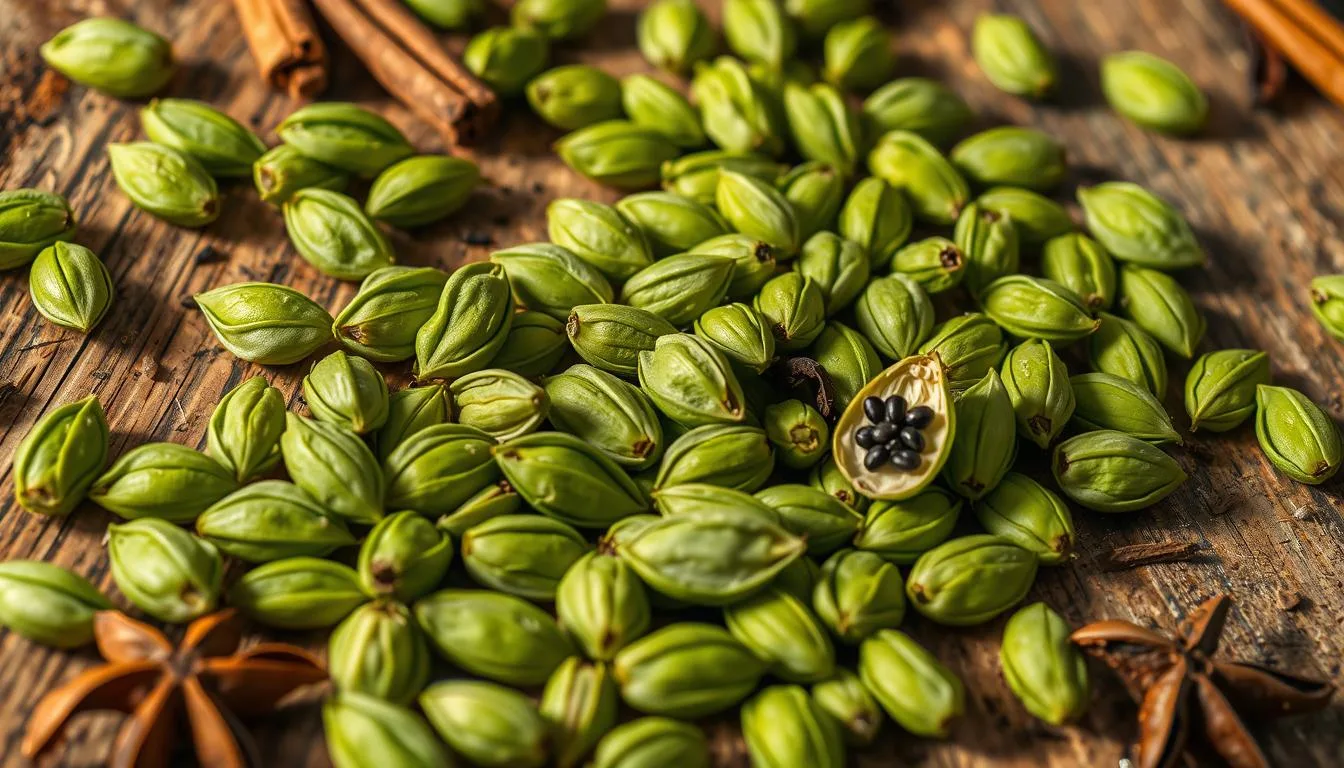Ever wondered about cardamom pods’ amazing smell and taste? This spice is key in Indian, Middle Eastern, and Scandinavian cooking. It makes dishes both sweet and savory special. But, you can enjoy cardamom in many ways,. Let’s dive into the world of fresh cardamom pods and discover its secrets.
Key Takeaways
- Discover the different types of cardamom and their distinct characteristics
- Understand the rich history and cultural significance of this ancient spice
- Learn how to source, select, and store high-quality cardamom pods
- Explore the versatile culinary applications of cardamom in sweet and savory dishes
- Understand the health benefits and sustainable harvesting practices for cardamom
Table of Contents
Understanding the Aromatic World of Cardamom
Cardamom is a fascinating spice that has captivated people for centuries. It comes in two main types: green and black cardamom. Green cardamom is more common and versatile. Black cardamom has a smoky flavor.
Different Types of Cardamom Available
The world of cardamom is diverse, with several unique varieties to explore:
- Green Cardamom – The most popular type, known for its intense fragrance and vibrant green color.
- Black Cardamom – Characterized by a robust, resinous flavor with earthy undertones, popular in Southeast Asian cuisines.
- White Cardamom – Bleached from green pods, it has a milder taste suited for Scandinavian and Middle Eastern dishes.
- Madagascar Cardamom – Standouts for their light green color and citrusy undertones, commonly used in African and tropical cuisine.
The Rich History of Cardamom Use
Cardamom has a long history, starting in ancient civilizations. This spread its influence across Asia, the Middle East, and Europe.
For thousands of years, cardamom has been important in traditional medicine and cooking.
Exploring whole cardamom pods or using cardamon seasoning can enhance your cooking. Discover the rich history and diverse varieties of cardamom.
What Makes Green Cardamom Special
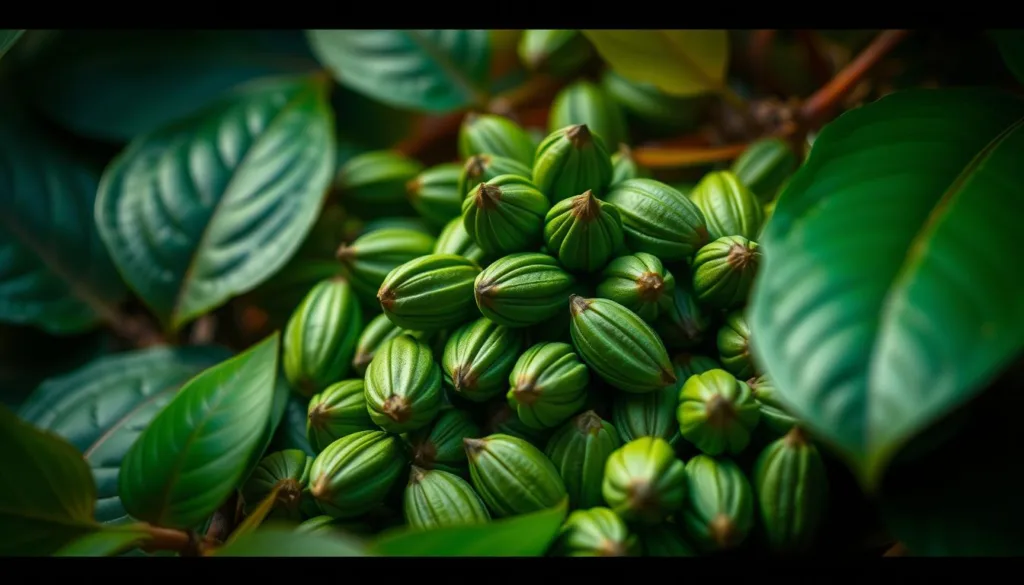
Green cardamom is a unique spice with a delicate flavor. Its pods have a sweet, floral smell with hints of mint and lemon. Inside, small black seeds hold essential oils, giving it a special taste.
Green cardamom is known for its versatility. It’s loved in many cuisines for its warm, subtle flavor.
| Characteristic | Green Cardamom | Black Cardamom |
|---|---|---|
| Flavor Profile | Sweet, floral, minty, and slightly bitter | Earthy, smoky, and robust |
| Aroma | Delicate, complex, and aromatic | Intense, pungent, and smoky |
| Origin | Native to India and Sri Lanka | Native to the Himalayas |
| Usage | Versatile in both sweet and savory dishes | Primarily used in savory, slow-cooked dishes |
Green cardamom is rare and expensive, making it a culinary gem. It’s the third most expensive spice, after saffron and vanilla. Its high demand and limited supply make it a prized ingredient.
The Natural Characteristics of Cardamom Pods
Physical Appearance and Structure
Cardamom pods are small and triangular. They have tiny seeds inside. True or green cardamom pods are light green, while black cardamom pods are dark brown and larger.
Each pod has a cluster of fragrant seeds. These seeds are the source of cardamom’s unique flavors.
Aroma and Flavor Profile
Cardamom pods have a complex aroma and flavor. The seeds inside contain essential oils. These oils give cardamom its special taste.
The flavor of cardamom is sweet, spicy, and aromatic. Green cardamom has a delicate, floral aroma. Black cardamom has a robust, smoky taste.
| Cardamom Type | Appearance | Aroma and Flavor |
|---|---|---|
| Green Cardamom (Elettaria cardamomum) | Light green pods | Delicate, floral aroma; sweet, subtle flavor |
| Black Cardamom (Amomum subulatum) | Larger, dark brown pods | Robust, smoky aroma; bold, earthy flavor |
Cardamom pods are versatile. They can make many dishes better, from desserts to curries and drinks. Whether you like green or black cardamom, these pods are a treat for your senses.
Sourcing and Selecting Quality Cardamom Pods
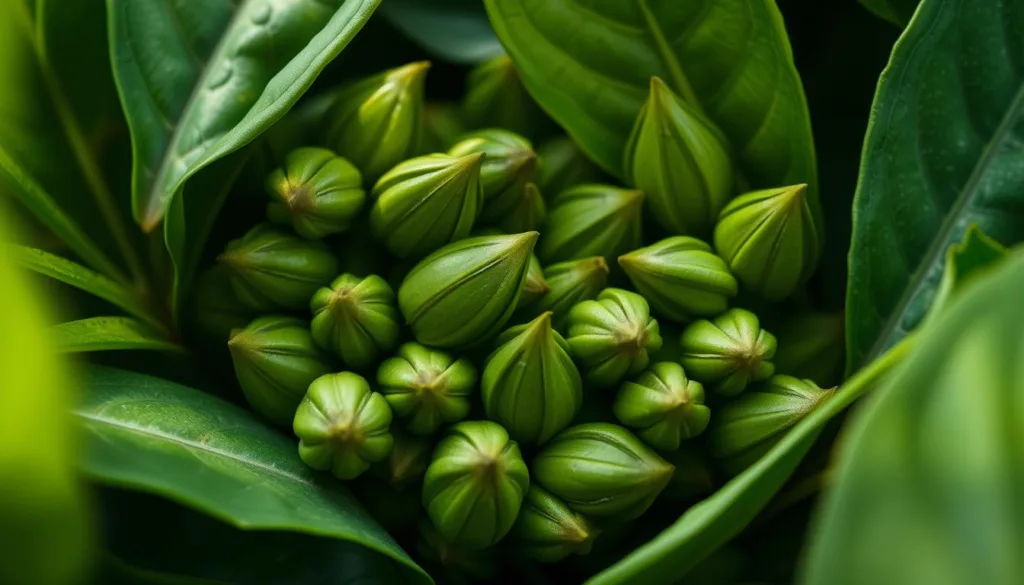
When looking for the best cardamom pods, choose vibrant, uniform ones with a strong smell. Fresh pods are bright green. Larger pods have more seeds, making them taste stronger.
Buy from trusted places for the freshest cardamom. Specialty shops, online stores, and farmers’ markets are good choices. Don’t pick pre-ground cardamom. Whole pods keep their flavor longer.
Choose pods that feel firm and oily. A “crush test” will show if they’re fresh. If the seeds smell good, they’re fresh. Avoid damaged or dull pods.
The cost of cardamom can show its quality. Cheap options might not taste as good. Spend more on high-quality cardamom for better taste.
Top suppliers like Kisan Agro focus on quality and care for the environment. They work with skilled growers in places like Kerala and the Eastern Ghats. This ensures you get the best cardamom.
Storage and Preservation Techniques
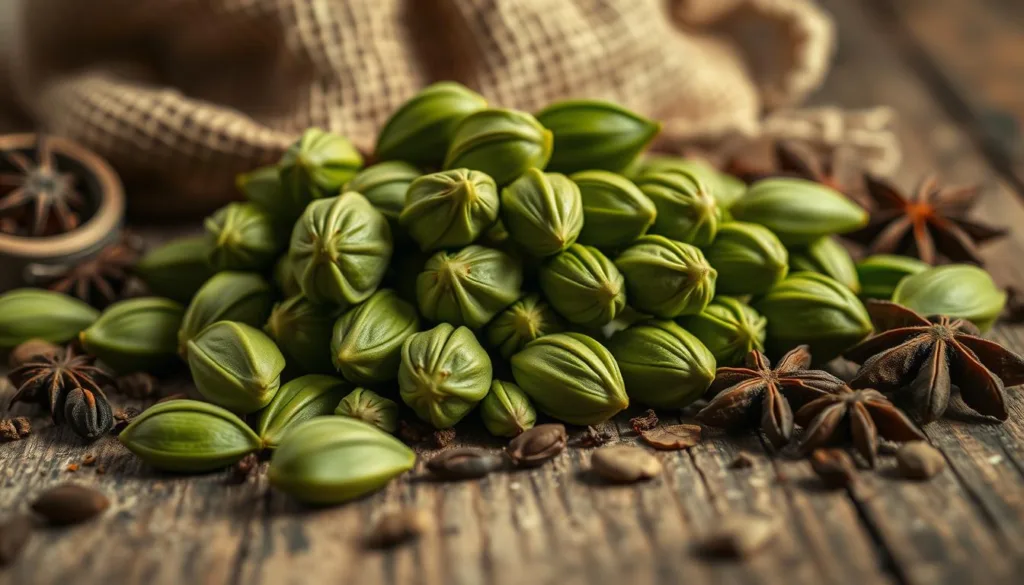
Keeping cardamom spice fresh is key. To keep your whole cardamom pods in top shape, try these storage tips:
Optimal Storage Conditions
Put cardamom flavoring pods in a sealed container. A glass jar or metal tin works well. Keep it in a cool, dark spot. The best temperature is between 50°F and 59°F (10°C to 15°C).
Also, keep the humidity around 50%. Light, heat, and moisture can make the pods lose their flavor.
Shelf Life and Freshness Tips
- Whole cardamom spice pods stay flavorful for up to a year if stored right.
- Ground cardamom doesn’t last as long, usually 6 months or less, because it loses its scent faster.
- Grind whole cardamom just before using to keep it fresh longer.
- Freezing cardamom flavoring pods can also help them last longer by slowing down the aging process.
- Check if the pods are fresh by looking for bright green color, firm texture, and a strong, unique smell.
By using these storage and preservation methods, your cardamom spice will stay flavorful and aromatic for a longer time.
Health Benefits of Fresh Cardamom
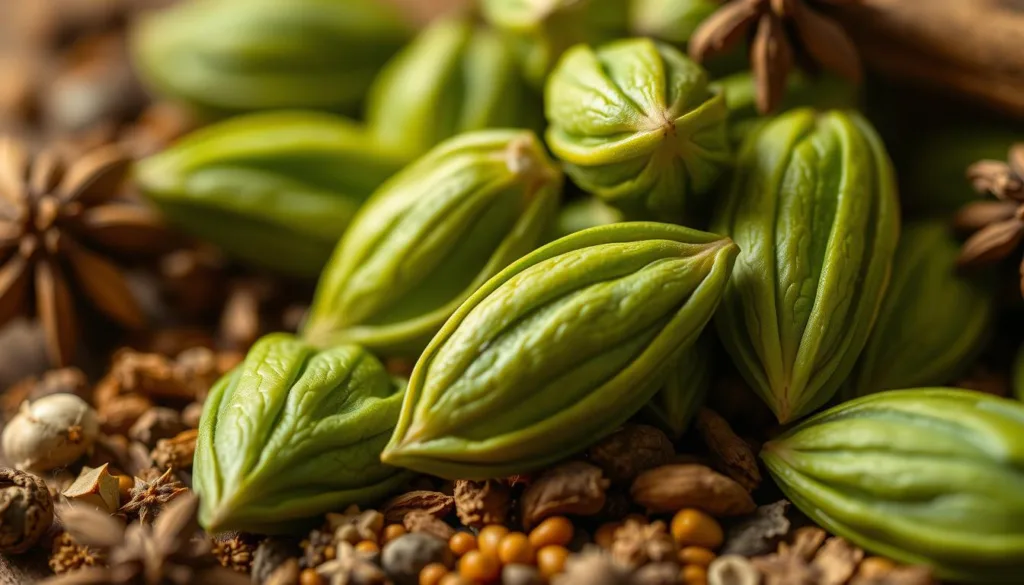
Cardamom has been used for health for a long time. New studies show it might help with heart health and keeping teeth clean.
A study with 20 adults with high blood pressure showed great results. They took three grams of green cardamom powder each day. Their blood pressure went back to normal in 12 weeks. Their antioxidant levels also jumped by 90%, helping with blood pressure.
Cardamom also fights inflammation and bacteria. It can help prevent tooth cavities and reduce bacteria in saliva by 54%. Studies on rodents show it might protect against stomach ulcers and liver inflammation.
Cardamom spice might also help with metabolism. A study with people at risk of diabetes and high cholesterol showed better health markers after 8 weeks. Another study found green cardamom helped people with type 2 diabetes manage their blood sugar and insulin.
More research is needed to know all the benefits of cardamom. But, the studies we have suggest it’s good for heart, teeth, and metabolism. It’s a natural remedy that could be great for a healthy diet.
Culinary Applications for Cardamom Pods
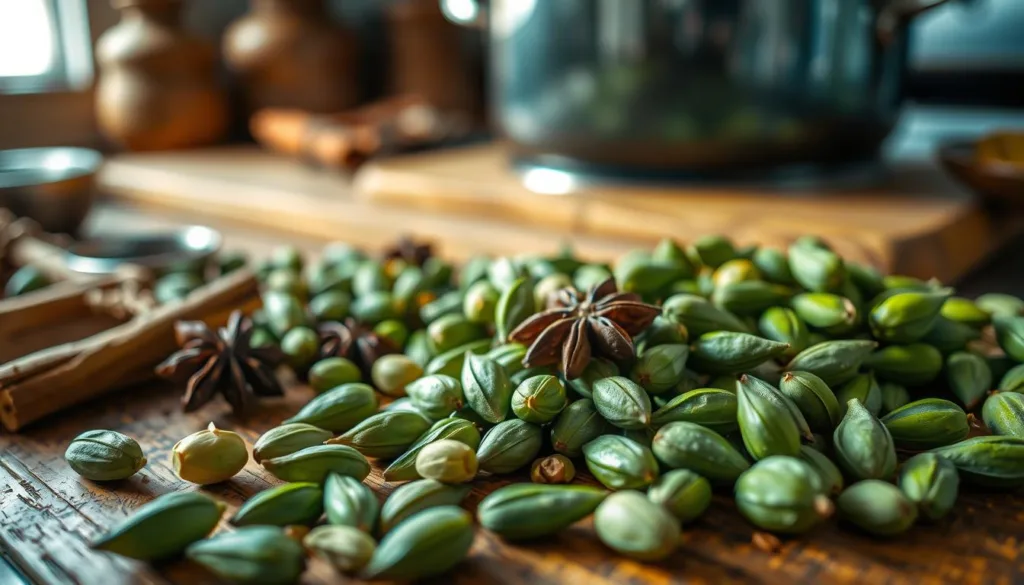
Sweet Dishes and Desserts
In desserts, cardamom pairs well with cinnamon. It’s a favorite in pulla (Finnish cardamom-infused bread), julekaka (Scandinavian Christmas bread), and cakes and cookies. Cardamom also adds warmth to creamy rice puddings, ice creams, and custards.
Savory Recipes and Spice Blends
Cardamom is key in many savory spice blends, like the Indian garam masala. It adds depth to meat dishes, vegetable curries, and aromatic rice. Lightly toasted and crushed, its pods bring an earthy, smoky flavor to savory recipes.
| Dish | Cardamom Application |
|---|---|
| Vegan Cinnamon Buns | Ground cardamom for a spiced dessert |
| Cauli Tikka Masala | Cardamom pods for an earthy flavor in the curry |
Cardamom’s unique aroma and flavor make it versatile in cardamom cooking. It enhances a variety of cardamon seasoning dishes. Its subtle complexity adds depth and interest to both traditional and modern dishes.
Traditional Uses in Global Cuisines
Cardamom is a key ingredient in many global cuisines. It shows its versatility and appeal. In Indian cooking, it’s a must in curries, rice, and chai tea.
In the Middle East, it’s used in coffee and desserts. Scandinavian bakers add it to pastries and breads, making their dishes unique.
In Africa and Latin America, cardamom cooking is also popular. It’s used in savory stews and sweet treats. This spice is celebrated worldwide for its flavor.
Cardamom is loved in India’s curries, the Middle East’s desserts, and Scandinavia’s baked goods. Its flavor and versatility make it a global favorite. It’s a key part of many cultures’ kitchens.
Grinding and Processing Methods
To get the most out of whole cardamom pods, you need to prepare them. First, separate the seeds from the pods. This step is key to releasing their amazing aroma and taste.
- Crack open the cardamom pods gently with your fingers or a spoon’s back.
- Grind the seeds into a fine powder using a spice grinder, coffee grinder, or mortar and pestle. Grinding them fresh brings out more flavor than pre-ground cardamom spice.
- For a smoother powder, grind the seeds with some sugar. The sugar makes the powder even and finer.
Grinding cardamom pods at home can save you up to 50% compared to buying pre-ground cardamom spice. Whole cardamom pods also last longer and taste fresher than ground ones.
When using whole cardamom pods in recipes, you can choose to remove them or leave them in. Leaving them in adds a stronger flavor. For dishes like traditional chai, the pods are simmered to infuse the liquid with their aroma.
The secret to enjoying cardamom pods fully is in the grinding. With a bit of care, you can add their unique flavors to your cooking.
Cardamom in Beverages and Teas
Cardamom is more than just a spice for savory dishes. It’s a key player in chai tea and new drinks. Its unique taste adds depth to many drinks, making it a favorite among spice lovers.
Traditional Chai Preparation
In chai tea, cardamom is a must-have. Its warm, spicy taste goes well with black tea. This mix has been loved for centuries. To make traditional chai, whole aromatic cardamom pods are simmered with cloves and ginger. This infuses the tea with a comforting scent.
Modern Drink Innovations
Cardamom is in smoothies, juices, and sparkling waters. It’s a hit with those looking for tasty, healthy drinks.
| Beverage | Cardamom Usage | Preparation Technique |
|---|---|---|
| Traditional Chai Tea | Aromatic cardamom pods | Simmering whole pods with black tea, milk, and other spices |
| Cardamom Cocktail | Cardamom spice-infused syrups, bitters, or tinctures | Muddling, infusing, or using as a garnish |
| Cardamom Smoothie | Cardamom flavoring in the form of ground spice or extract | Blending with fruits, yogurt, and other ingredients |
Cardamom is loved in both traditional chai and new drinks. It shows how versatile and appealing this spice is to coffee and tea fans.
Sustainable Harvesting Practices
I love green cardamom pods and think it’s key to talk about how they’re harvested. It’s important to make sure this spice is here for the long run. Responsible farmers are using methods that are good for the planet and fair to everyone involved.
Good cardamom farming means taking care of the environment. Farmers grow cardamom with other plants and trees. This keeps the natural balance and helps animals and plants live together.
Organic cardamom is another big deal. It’s made without harmful chemicals. This makes the cardamom better for the earth and tastes better too.
- Selective Sourcing: Partnerships with experienced cardamom growers using traditional and sustainable methods.
- Hand-Harvesting: Careful handpicking at peak maturity levels for maximum essential oil content.
- Rigorous Drying: Steps like air drying and sun drying to preserve natural flavors.
- Grading and Sorting: Sorting by size, color, and quality to ensure uniformity.
- Airtight Storage: Storage in cool, dry, and airtight facilities for freshness preservation.
Also, fair trade is important in cardamom. It makes sure farmers get paid well and work in good conditions. This helps communities and keeps things stable for a long time.
| Sustainable Practices | Benefits |
|---|---|
| Organic Farming | Avoids synthetic pesticides and fertilizers, preserves soil health and biodiversity. |
| Intercropping | Maintains forest ecosystems and promotes natural pest control. |
| Fair Trade | Ensures better working conditions and fair compensation for cardamom farmers. |
By using these practices, cardamom farmers make sure their product is top-notch. They also help keep the spice around for a long time. As someone who cares about quality, I’m happy to support these efforts. I enjoy the amazing taste and smell of cardamom pods that are made responsibly.
Common Substitutes for Cardamom
Cardamom spice has a unique flavor. But, if you’re out of it, you can use cinnamon and ginger. They can give a warm, spicy taste like cardamom. Nutmeg or allspice can also be used, but they won’t taste exactly the same.
A mix of cinnamon, nutmeg, and ginger can be a good cardamon seasoning substitute. It won’t taste the same, but it adds warmth and depth to your dish.
Green cardamom is used in sweet recipes, while black cardamom is for savory dishes. Remember this when substituting to get the best flavor.
| Substitute | Best Use | Ratio |
|---|---|---|
| Cinnamon and Ginger | Sweet and savory dishes | 1:1 |
| Nutmeg | Baked goods and desserts | 1:1 |
| Allspice | Savory recipes and sauces | 1:1 |
| Mace | Sauces, curries, and rubs | 1:1 |
These aromatic cardamom substitutes can give a similar taste. But, they won’t be exactly the same as cardamom. Try different mixes to find what works best for your recipe and taste.
Price Factors and Market Trends
As someone who loves cardamom pods and green cardamom, I know it’s very expensive. It’s only beaten by saffron and vanilla. The cost of cardamom spice changes due to many things. These include the harvest conditions, demand from countries that make it, and global market trends.
Recently, I’ve seen more people wanting cardamom, mainly in Western countries. This is because Middle Eastern and Indian foods are getting more popular. The price and how easy it is to find cardamom have changed a lot. It’s interesting to see how the cardamom world is changing to meet different tastes.
Even with ups and downs in price and supply, I’m hopeful for the cardamom market’s future. New farming tech and focus on green harvesting are helping. I’m looking forward to seeing how cardamom will be used in cooking more and more.
FAQ
What is cardamom and what are its main varieties?
What is the flavor profile of green cardamom?
How should I select and store high-quality cardamom pods?
How do I grind and use whole cardamom pods?
What are some common substitutes for cardamom?
If you liked this article, you might also like :
- Low Carb Breakfast Recipes from our Breakfast category.
- Nacho Trays from our Lunch category.
- Fajitas de Pollo from our Dinner category.
Follow us on Facebook, Instagram, Pinterest, X and Youtube for the latest news, tips, and exclusive content.

